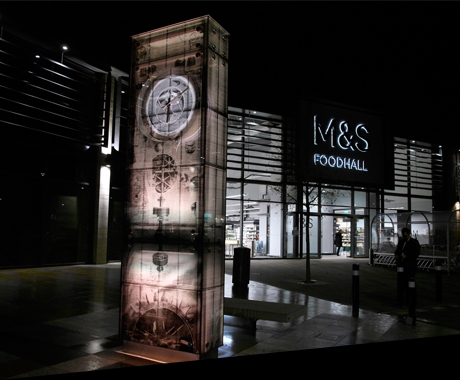Created by artist Kirsty Brooks, the clock tower at the heart of the development at Kirkstall Bridge is as a response to the industrial history of the area. The screen-printed glass cladding features images of industrial artefacts and processes specific to the area.
Each visual component of the clock mechanism is created from photographs of surrounding industrial elements: the pendulum – a forge-made vehicle axle, the clock face – the original Thrift Stores clock. The clock tower itself is wrapped in an image of a woollen spool, reflecting the blanket making and textile fulling activities carried out nearby.
JPLD were appointed by the artist and creator of the tower, Kirsty Brooks, to develop a subtle lighting scheme which emphasised the elements described in the narrative while helping to establish the piece against a visually busy backdrop.
James Poore, JPLD, said: ‘After testing various sources the obvious choice for the backlighting of the clock-face was dimmable LED Light Sheet, we have used it extensively on numerous retail and interior projects and the ability to create bespoke forms and shapes was ideal for this application. By stepping the LED Light Sheet back and using a diffuser disc behind the glass, we were able to achieve a completely uniform illumination of the face. The ability to control the light intensity of the light output, allowed us to tune the clock face lighting to the daylight ambient level to ensure it is visible yet “comfortable” to view regardless of the time of day.’
In appreciation of the industrious energy of the site and the people who occupied it, the internal tower lighting is subtly changed to loosely reflect or respond to natural circadian body rhythm requirements; cooler white light in the morning with a blue light fade on the hour moving through a red fade at midday through to a warmer white into the afternoon.
The design and treatment of the glass was adapted by Brooks and Proto Studios in conjunction with JPLD’s lighting concept to maximise the light transmission and diffusion as well as the concealing of the luminaires and controls.
A simple yet robust scheme was created using RGBW linear luminaires to achieve the internal lighting and backlighting of the main glass. The whole system is programmed and controlled via a basic Pharos control unit housed in an enclosure in the base with a daylight sensor on top of the tower to monitor changes in ambient light level.
www.jpld.co.uk
www.kirstybrooks.co.uk
www.protostudios.com
If you found this interesting, feel free to tweet about it.




